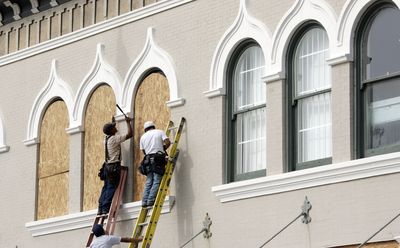Gulf Coast waits as Cuba faces cleanup

NEW ORLEANS – With a historic evacuation of nearly 2 million people from the Louisiana coast complete, gun-toting police and National Guardsmen stood watch as rain started to fall on this city’s empty streets Sunday night – and even presidential politics took a back seat as the nation waited to see if Hurricane Gustav would be another Katrina.
The storm was set to crash ashore late this morning with frightful force, testing the three years of planning and rebuilding that followed Katrina’s devastating blow to the Gulf Coast. The storm has already killed at least 94 people on its path through the Caribbean.
Painfully aware of the failings that led to more than 1,600 deaths during Katrina, this time officials moved beyond merely insisting that tourists and residents leave south Louisiana. They threatened to put looters behind bars, loaded thousands onto buses and warned that anyone who remained behind would not be rescued.
They were confident that they had done all they could.
“It’s amazing. It makes me feel really good that so many people are saying, ‘We as Americans, we as the world, have to get this right this time,’ ” New Orleans Mayor Ray Nagin said late Sunday. “We cannot afford to screw up again.”
Col. Mike Edmondson, state police commander, said he believed that 90 percent of the population had fled the Louisiana coast. The exodus of 1.9 million people is the largest evacuation in state history, and thousands more had left from Mississippi, Alabama and flood-prone southeast Texas.
Late Sunday, Gov. Bobby Jindal issued one last plea to the roughly 100,000 people still on the coast: “If you’ve not evacuated, please do so. There are still a few hours left.”
Louisiana and Mississippi temporarily changed traffic flow so all highway lanes led away from the coast, and cars were packed bumper to bumper.
Forecasters said Gustav could strengthen slightly as it marched toward the coast. At 11 p.m. EDT Sunday, the National Hurricane Center said Gustav was centered about 220 miles southeast of New Orleans and was moving northwest. It had top sustained winds of 115 mph, and was likely to stay a Category 3 storm when it made landfall west of New Orleans. Category 3 storms have winds between 111 mph and 130 mph.
In Cuba, Gustav damaged or destroyed 86,000 homes, toppled trees and telephone poles and washed out roads, but no deaths were reported Sunday as the massive storm roared away from the island.
Gustav made a direct hit on the Isla de la Juventud south of the Cuban mainland as a powerful Category 4 hurricane Saturday with screaming 140 mph winds.
Officials measured gusts of 212 mph in the western town of Paso Real del San Diego – a new wind speed record, according to the Cuban Institute of Meteorology.